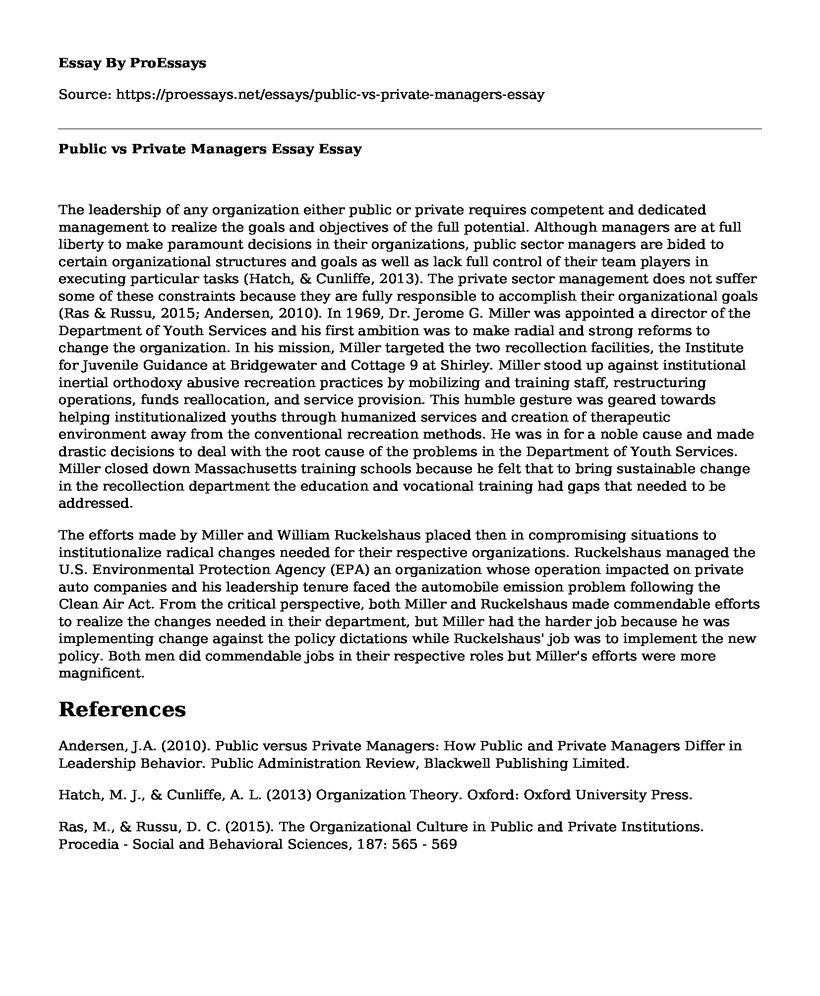The leadership of any organization either public or private requires competent and dedicated management to realize the goals and objectives of the full potential. Although managers are at full liberty to make paramount decisions in their organizations, public sector managers are bided to certain organizational structures and goals as well as lack full control of their team players in executing particular tasks (Hatch, & Cunliffe, 2013). The private sector management does not suffer some of these constraints because they are fully responsible to accomplish their organizational goals (Ras & Russu, 2015; Andersen, 2010). In 1969, Dr. Jerome G. Miller was appointed a director of the Department of Youth Services and his first ambition was to make radial and strong reforms to change the organization. In his mission, Miller targeted the two recollection facilities, the Institute for Juvenile Guidance at Bridgewater and Cottage 9 at Shirley. Miller stood up against institutional inertial orthodoxy abusive recreation practices by mobilizing and training staff, restructuring operations, funds reallocation, and service provision. This humble gesture was geared towards helping institutionalized youths through humanized services and creation of therapeutic environment away from the conventional recreation methods. He was in for a noble cause and made drastic decisions to deal with the root cause of the problems in the Department of Youth Services. Miller closed down Massachusetts training schools because he felt that to bring sustainable change in the recollection department the education and vocational training had gaps that needed to be addressed.
The efforts made by Miller and William Ruckelshaus placed then in compromising situations to institutionalize radical changes needed for their respective organizations. Ruckelshaus managed the U.S. Environmental Protection Agency (EPA) an organization whose operation impacted on private auto companies and his leadership tenure faced the automobile emission problem following the Clean Air Act. From the critical perspective, both Miller and Ruckelshaus made commendable efforts to realize the changes needed in their department, but Miller had the harder job because he was implementing change against the policy dictations while Ruckelshaus' job was to implement the new policy. Both men did commendable jobs in their respective roles but Miller's efforts were more magnificent.
References
Andersen, J.A. (2010). Public versus Private Managers: How Public and Private Managers Differ in Leadership Behavior. Public Administration Review, Blackwell Publishing Limited.
Hatch, M. J., & Cunliffe, A. L. (2013) Organization Theory. Oxford: Oxford University Press.
Ras, M., & Russu, D. C. (2015). The Organizational Culture in Public and Private Institutions. Procedia - Social and Behavioral Sciences, 187: 565 - 569
Cite this page
Public vs Private Managers Essay. (2022, Jun 06). Retrieved from https://proessays.net/essays/public-vs-private-managers-essay
If you are the original author of this essay and no longer wish to have it published on the ProEssays website, please click below to request its removal:
- Term Paper on Management - Advantages of Scenario Planning
- Cradle to Cradle - Essay Example
- Gender Discrimination at Workplaces Essay
- The Management of Pizza Palace Mini Case Review
- Essay Sample on Organizational Culture: Value, Norms, and Artifacts
- Essay Sample on Globalization: Benefits, Impacts and Challenges
- Essay on Term Leader Brought Cooperation to My Class: Achieving Efficiency with Google Docs







